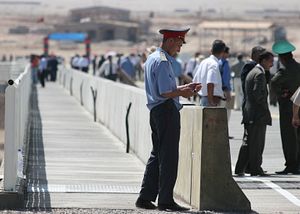Many people would struggle to find Tajikistan on map, but the world’s biggest players, the United States, Russia, and China, send the small former-Soviet republic millions of dollars in security assistance every year. A substantial part of the U.S. aid is counternarcotics assistance aimed at combating the flourishing opiate trade originating in Afghanistan. As common sense as that may appear on the surface, the sad reality is that counternarcotics security assistance to Tajikistan exacerbates corruption and helps support a quasi state-run drug cartel. As long as poor governance practices persist, these security assistance investments are akin to throwing money in a blazing fire.
Since the collapse of the Soviet Union, Tajikistan has remained the poorest country in Central Asia; migrant remittances comprise the equivalent of between a quarter and a half of the country’s GDP, one of the highest rates in the world. Some estimates report drug trafficking covers between a third and a half of Tajikistan’s economy. Sadly, for many young Tajiks, the only alternative to migrant work is the drug trade.
The strength of Tajikistan’s drug trade is a threat to stability and, according to U.S. assessments, American security interests as well. Since 2001 the U.S. has recognized Central Asian drug trafficking as a source of financing for terrorist groups. Understandably, the push behind the “War on Terror” heavily influences international approaches to providing counternarcotics assistance, making it highly militarized. Although the U.S. Commission on International Religious Freedom has classified Tajikistan as a country of particular concern since 2012, the State Department has repeatedly waived sanctions in an effort to expand ongoing security cooperation, despite harsh restrictions imposed by Dushanbe on religious freedoms.
The commonality of corruption in Tajik law enforcement should give pause to U.S. policymakers. An emerging paradox is that Tajikistan’s drug-prohibition regime cements an alliance between corrupt state officials and traffickers. Cartels with proper connections thrive under current conditions, while smaller traffickers and drug users bare the brunt of enforcement. Both President Emomali Rahmon’s inner circle and the opposition are involved with trafficking and racketeering. Rahmon has forced many political opponents to leave the country and his government has repeatedly used drug raids as cover for arresting political opposition.
Due to the nature of assistance, many of the units conducting these raids are U.S.-trained, drawing a direct line between U.S. assistance and suppression of political freedom. Moreover, economic growth insufficiently explains Dushanbe’s construction boom or why civil servants own lavish houses and vehicles above their means. These flashy possessions in Central Asia’s poorest country undermines trust in state institutions; almost half of Tajik’s believe the majority of state officials are guilty of taking bribes.
Although trafficking contributes to a significant number of security concerns, the best method of tackling the cartels may not be so militarized. The sidelining of drug-abuse and HIV prevention assistance wreaks havoc on a populace that lacks access to treatment. The United Nations Office on Drugs and Crime from 2004-2007 spent well over three-quarters of the Central Asia budget on counternarcotics enforcement and only one-tenth on drug abuse and HIV prevention. The 2015-2019 UNODC projected budget reported that enforcement made up 43 percent of the budget and prevention accounted for less than a quarter. However, drug abuse and HIV prevention only accounted for 3 percent of the secured budget whereas enforcement accounted for nearly two-thirds. Counternarcotics enforcement is UNODC’s number one priority, in part, because it’s the number one priority of its donors. The military focus on combating the drug trade misses the broader societal implications of opiate trafficking.
Similarly, U.S. assistance is highly militarized and centers on enforcement training and equipment transfers to combat trafficking. According to the Security Assistance Monitor, the United States has provided over $181 million in counter-drug assistance across three programs between 2000 and 2019, and produced more than 4,750 Tajik trainees. In 2017 alone, the United States spent over $3.7 million to train 318 members of Tajikistan’s riot police, whose former commander defected to ISIS in 2015. The equipment and trainees are then often used by the state’s riot police or other units in cracking down on opposition. Sometimes, other kinds of aid may unwittingly contribute to the problem. For example, the Nizhny-Panj bridge, built at the Afghanistan-Tajikistan border and financed by the U.S. Army Corps of Engineers, enables the trafficking of increased amounts of opiates. Law enforcement, thus-far, seems unable to stop traffickers.
Indeed, a baffling correlation has emerged: Often, when opium supply in Afghanistan increases, seizures in Tajikistan decrease. Afghanistan produced 4,200 metric tons of opium in 2004, yet only 5 metric tons of heroin or its equivalent in opium were seized in Tajikistan. In 2008 Afghan cultivation rose to 7,700 metric tons of opium, but Tajik authorities seized less than 2 metric tons. Meanwhile, the United Nations Office on Drugs and Crime (UNODC) reports that Tajikistan’s Drug Control Agency (DCA) has been very cooperative, signing 43 national and international agreements to fight drug trafficking. The low amount of seizures in both countries suggests that regional law enforcement is either incapable or disinterested in stemming the flow of opiates and the wide pervasiveness of corruption.
As it stands, U.S. assistance does not prevent a flourishing drug trade flowing through Tajikistan. Counternarcotics assistance to Tajikistan has failed to yield benefits for Tajik society and drug trafficking will continue to threaten regional stability as long as corruption persists unabated. Not only is militarized counternarcotics assistance to Tajikistan akin to throwing money into a fire, it is fanning the flames.
Ian Wallace is a research associate at the Security Assistance Monitor focusing on the Middle East and North Africa. He has conducted research in Morocco and Tajikistan on social movements, nationalism, and issues of governance across the MENA region. Twitter: @eeyoan.

































